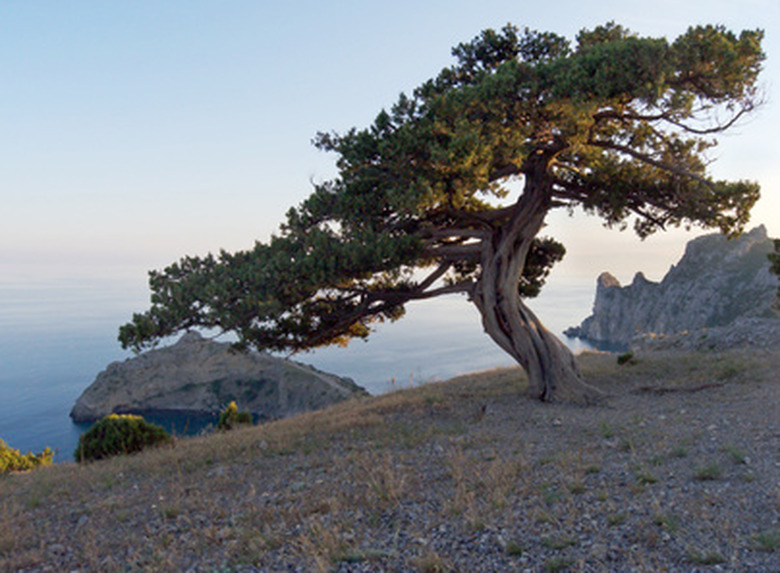The History Of Juniper Trees In Central Oregon
The history of the western juniper, Juniperus occidentalis, a small tree with twisted, gnarled bark, is ordinarily divided between those stands that grew before the arrival of settlers in the late 1860s and 1870s to the rapid expansion of juniper woodlands that followed. The decade of the 1870s is the turning-point of what are called pre- and post-settlement stands of juniper.
The Distance Past
The size and dominance of western juniper woodlands has fluctuated greatly during the past 5,000 years. Studies of pollen suggest that the western juniper declined 500 years before pioneer settlement. Post-settlement stands are denser and occupy more productive and deeper soil.
Human Uses
Native Americans used juniper branches as digging sticks and turned its scaly bark into baskets, mats and sandals. They made a tea from its berries to fight colds, as a diuretic, and to ease the pain of giving birth. Central Oregon pioneers used it as firewood and to make poles for corrals, fences, and simple shelters.
- The history of the western juniper, Juniperus occidentalis, a small tree with twisted, gnarled bark, is ordinarily divided between those stands that grew before the arrival of settlers in the late 1860s and 1870s to the rapid expansion of juniper woodlands that followed.
Pre-Settlement Woodlands
The soils in the Mazama Ecological Province in central Oregon, just east of the Cascade Mountains, supports some of the most extensive stands of old growth juniper. The Mazama Province was formed by the explosive volcano, Mt. Mazama, home to Crater Lake National Park. These pre-settlement trees flourished in the loose volcanic soil and high desert climate.
In looking for older trees, researchers look for deeply furrowed bark, twisted branches and trunks, large lower limbs and branches covered with a bright yellow-green lichen. The height and trunk size does not correlate well with age. Slow decomposition in central Oregon's dry climate allowed burning stumps and standing trees to survive for hundreds of years. Old growth stands contain 63 percent of trees older than 200 years.
- The soils in the Mazama Ecological Province in central Oregon, just east of the Cascade Mountains, supports some of the most extensive stands of old growth juniper.
Researchers at Oregon State University have found several trees from 1,200 to 1,600 years old. However, less than 3 percent of the current 5 million acres of western juniper trees extending from northern California through central and eastern Oregon are more than 100 years old.
Areas overgrazed by cattle near Bend and Redmond, Oregon, which lie below 5,000 feet, are dominated by bitterbrush and cheat grass, not juniper.
Post-settlement Woodland
Mature juniper trees lack a central taproot; its strong roots spread wide and are capable of penetrating deep into the cracks of central Oregon's volcanic rocks. In the process, these roots push aside stands of big sagebrush, low sagebrush, antelope brush, gray and green rabbit brush and other high desert shrubs that hold the soil in place.
In the 1960s, tractors were used to drag huge anchor chains through stands of juniper. In order to do less damage to the land, anchor-chains were replaced by chainsaws in the 1970s. The result was that less sediment flowed into streams. Streams returned that were formerly dry and seasonal wet spots reappeared. Native Americans burned juniper, but that practice risks eliminating desirable shrubs, turning the land over to noxious weeds. If the trees are cut and not removed, their dry remains pose a fire hazard.
- Researchers at Oregon State University have found several trees from 1,200 to 1,600 years old.
Reasons for Post-settlement Growth
Researchers believe there are three main reasons for the rapid expansion of post-settlement juniper woodlands. First, overgrazing by cattle reduced the indigenous high-desert grasses that ordinarily contributed to fires that once swept through stands of juniper. Second, studies of tree ring growth show that the weather was mild and precipitation increased from 1850 to 1916, which encouraged the growth of juniper. Third, industrially produced carbon dioxide in the atmosphere is believed to be increasing woody species and accelerating the growth of tree canopies throughout the West.
Environmental Concerns
Concerns are raised between the necessity of stopping the invasive spread of newer stands of juniper and the old growth woodlands that are esthetically pleasing and spiritual to many and have recreational uses. Mountain bluebirds and red-and-white-breasted nuthatches and other species use old-growth woodlands of western juniper for their habitat. There are typically more birds, wood rats and other small animals in pre-settlement stands than more recent growth. More than 80 species of animals live in the snags, logs, decaying and hollow trees of old growth juniper.
- Researchers believe there are three main reasons for the rapid expansion of post-settlement juniper woodlands.
- First, overgrazing by cattle reduced the indigenous high-desert grasses that ordinarily contributed to fires that once swept through stands of juniper.
